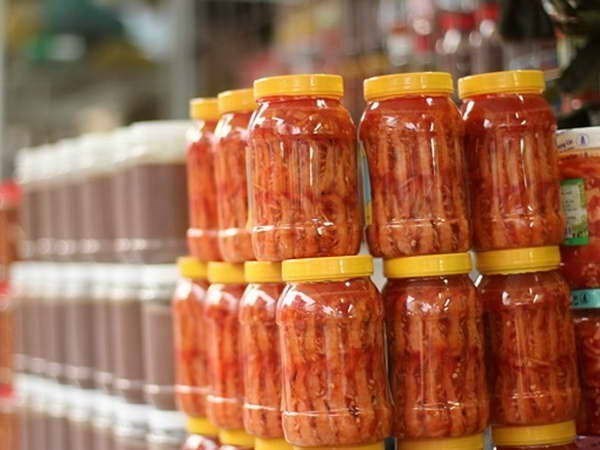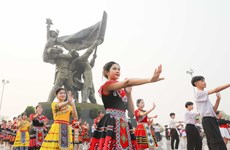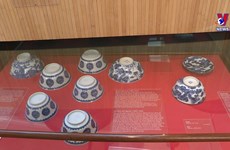Tet specialties of different regions across Vietnam
Hanoi (VNA) - Rich or poor, Vietnamese at home or abroad carefully cook traditional dishes to put on the home altar to worship their ancestors during Tet (Lunar New Year) festival.
At Tet, each region has its own culinary specialties that reflect the culture of their people. Most Vietnamese people start preparations a month before the festival.
These carefully cooked traditional dishes are put on the home altar to worship their ancestors during Tet festival.
Right before the New Year Eve, the meal will be officially offered to ancestors on the altar, as the oldest man of the family will burn the incense and say the prayers.
Besides common dishes, such as sticky rice cakes and spring rolls, Lunar New Year meals in different regions have their own touches.
The northern region
Only ranking behind banh chung in importance, boiled chicken is also an essential part of the New Year meal. Some believe the dish represents a lucky new start to the family.
 Dong Tao chicken originated from Khoai Chau (Hung Yen province) wins consumers’ favour thanks to its bold taste and unique shape. (Photo: VNP/VNA)
Dong Tao chicken originated from Khoai Chau (Hung Yen province) wins consumers’ favour thanks to its bold taste and unique shape. (Photo: VNP/VNA)Though it is really common to see a variety of soups, fried, boiled, or stewed dishes, meat, fish, vegetable, the citizens of Hanoi have come up with a special dish that cannot be mistaken to any other places.
The soup includes dried pork skin, shrimp, lean pork, several seasonal vegetables including broccolis and carrots and cooked meat stock. Not to mention that making the stock was really complicated. It includes the stock from chicken and shrimp and thus has both the sweet and light flavours.
The Tet menu also includes specialties from different provinces in the North, such as sticky rice, Vu Dai-styled stewed fish, sausage, bamboo shoot soup, Thanh Hoa fermented meatball, etc.
For dessert, people in the northern region often go for Dai Hoang banana (Ha Nam province), Cao Phong orange (Hoa Binh province); Vinh orange (Nghe An) and Dien pomelo.
The central region
Taking the former royal capital city of Hue as representative of the central region, banh chung and banh tet are the most important Tet dishes, as in other regions. The sticky rice cakes made with a stuffing of green bean and pork symbolize the wet-rice cultivation that the nation has subsisted on for centuries.
While people in the north prefer banh chung – square cake, Hue residents prefer banh tet – the cylinder sticky rice cake that is said to symbolize a shoulder pole (the Centre) carrying two baskets (the North and the South) at either ends.
Another difference that can be seen is that the sizes of the cakes are smaller in the central region. Hue residents like to claim that this denotes an emphasis for sophistication rather than volume, as also greater skills required to shape and wrap the smaller cakes.
While banh chung and banh tet are the items that Hue inherited from ancestors who came in from the North, dua mon is a ‘endemic’ Tet dish of locals.
Dua mon is as an accompaniment to banh chung and banh tet in order to enjoy a combination of different tastes - sweet, salty, fatty and spicy.
Predicting the Tet weather in Hue is a difficult task. It might be hot at above 30 Celsius degrees or be cold under 15 Celsius degrees with continuous rains for a week. With such unpredictable weather conditions, banh tet and dua mon are the best choices for Tet food, since they can be preserved for up to 15 days, and people do not have to spend too much time in the kitchen.
Most Vietnamese men drink alcohol to celebrate Tet. And as a tradition, Hue women also prepare food for the drinkers, like sour shrimp, slices of pig stomach and Roxburgh fig (Ficus auriculata) soaked in sweetened fish sauce.
 Sour shrimp, a specialty of Thua Thien-Hue province (Source: hues.vn)
Sour shrimp, a specialty of Thua Thien-Hue province (Source: hues.vn)The southern region
Blessed with a lot of sunlight and rich soil to grow plants and vegetables all year round, the southern region enjoys an abundance of fruits, vegetables and seafood. So there is unmistakable prosperity here, compared to other rural regions in the country.
 Tet cake of Can Tho City (Photo: VNP/VNA)
Tet cake of Can Tho City (Photo: VNP/VNA)Their Tet food, apart from the banh chung and banh tet, are easy to cook, with some of the more popular dishes including pork cooked in coconut milk and a soup cooked with bitter gourd stuffed with mushrooms and pork.
Coconut palms can be found everywhere in the South, and bitter gourds grow in just about every garden. The fruit is called kho qua in the south.
Literally, kho means hardships in life and qua means over. The kho qua soup conveys the wish to overcome hardships in the coming year./.












